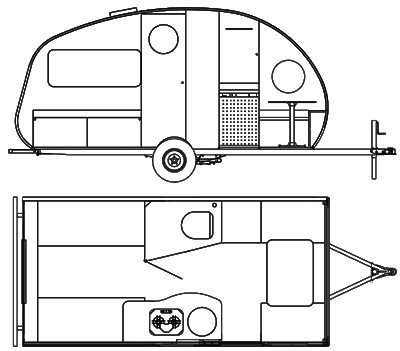Spent 5 nights at Joshua Tree, longest time I have spent with my trailer with no hookup; no power, water, or dump station is available at Indian Cove Campground. With the small holding tanks in my trailer (60L freshwater, 60L grey, 45L black), that’s really pushing the limit of what I can manage. I had three 19L jerrycans of freshwater with me, which I keep in the X on the floor behind the front row seats (since it’s just my wife and I this is the perfect place for them). As it is winter, the sun is very low in the sky and there was some overcast, so my solar produced only 500 to 700Wh/day but my 600Ah of battery storage was more than sufficient for that time period. Temps were 42F high, 34F low, so I had to burn propane to stay warm when we weren’t out hiking but my 24.5L/6.47gal propane tank proved to be adequate.
One challenge was the black tank filling up. I could have used the vault toilets at the campground, but I dislike the smell. The biggest challenge was the grey tank filling up. With both of us taking a daily shower that meant being extremely parsimonious with the water. When we camp at warmer times of the year we use the outside shower head and have a small pop-up tent for privacy if we are at a campground; that dramatically decreases the amount of water in the grey tank. But with Joshua Tree temps in the 30’s, outside showering was not on the agenda. On one day we showered at an RV campground about 8 miles away where some friends we hiked with were staying with their 21 ft fifth wheel, which they tow with a big diesel pickup truck.
On one day we showered at an RV campground about 8 miles away where some friends we hiked with were staying with their 21 ft fifth wheel, which they tow with a big diesel pickup truck.
Our next stop after Joshua Tree was Santa Barbara. Had remarkably low energy usage on the trip from the Rancho Cucamonga Supercharger to the Oxnard Supercharger: averaged 465Wh/mi at 55 to 58mph. Lowest energy usage I have ever achieved while towing over a long stretch of freeway. It was very windy in Riverside and LA counties, most of which was a crosswind (saw a big rig on its side on 10 in Fontana) but I suspect for part of the time I had a tailwind.
It is much warmer in Santa Barbara and our campground there has hookups. But as with many RV campgrounds, the quality of the electrical plugs at campsites can be marginal. The 50A/240V outlet at my site will not charge the car for more than a few minutes. I dialed it down in the car to 30A but after a few minutes of charging the campsite breaker flips. Perhaps a poor ground. So I charged the car overnight on the 30A/120V outlet, set to 25A just to be safe. That worked, albeit at a rate of 7 miles range/hour. It’s enough. Next time I decide to stay in Santa Barbara there will be Superchargers. Three sites have been permitted and one is under construction right now Supercharger - Goleta (Under construction Dec 2019, 12 stalls) .
Hiking in Joshua Tree at 4,300 ft, two days after the snowfall.


One challenge was the black tank filling up. I could have used the vault toilets at the campground, but I dislike the smell. The biggest challenge was the grey tank filling up. With both of us taking a daily shower that meant being extremely parsimonious with the water. When we camp at warmer times of the year we use the outside shower head and have a small pop-up tent for privacy if we are at a campground; that dramatically decreases the amount of water in the grey tank. But with Joshua Tree temps in the 30’s, outside showering was not on the agenda.
Our next stop after Joshua Tree was Santa Barbara. Had remarkably low energy usage on the trip from the Rancho Cucamonga Supercharger to the Oxnard Supercharger: averaged 465Wh/mi at 55 to 58mph. Lowest energy usage I have ever achieved while towing over a long stretch of freeway. It was very windy in Riverside and LA counties, most of which was a crosswind (saw a big rig on its side on 10 in Fontana) but I suspect for part of the time I had a tailwind.
It is much warmer in Santa Barbara and our campground there has hookups. But as with many RV campgrounds, the quality of the electrical plugs at campsites can be marginal. The 50A/240V outlet at my site will not charge the car for more than a few minutes. I dialed it down in the car to 30A but after a few minutes of charging the campsite breaker flips. Perhaps a poor ground. So I charged the car overnight on the 30A/120V outlet, set to 25A just to be safe. That worked, albeit at a rate of 7 miles range/hour. It’s enough. Next time I decide to stay in Santa Barbara there will be Superchargers. Three sites have been permitted and one is under construction right now Supercharger - Goleta (Under construction Dec 2019, 12 stalls) .
Hiking in Joshua Tree at 4,300 ft, two days after the snowfall.







